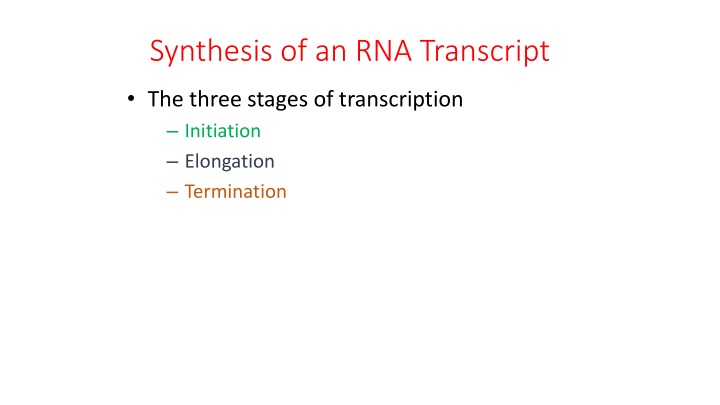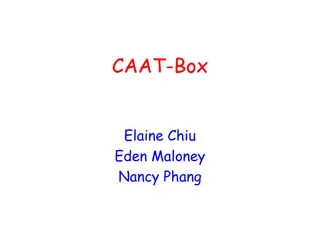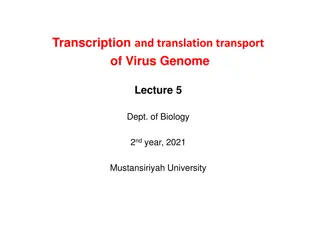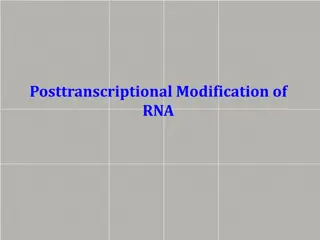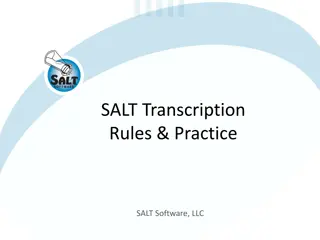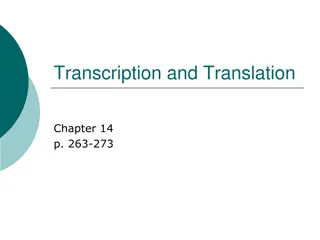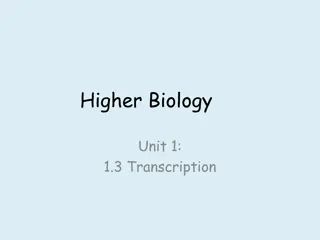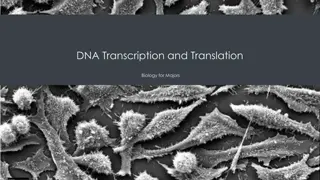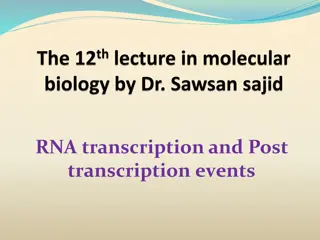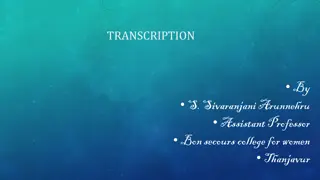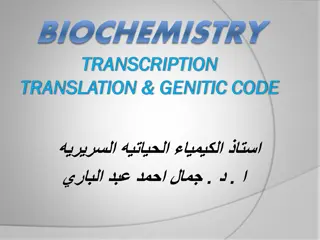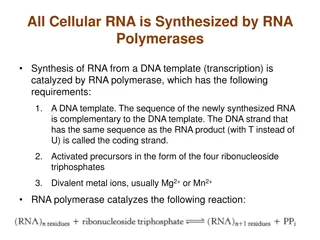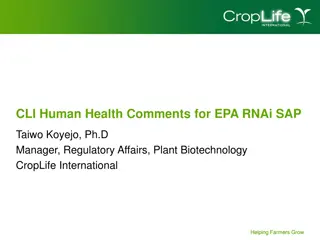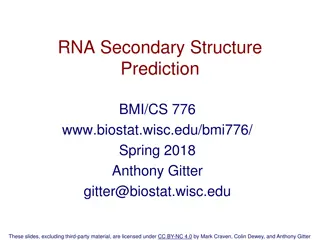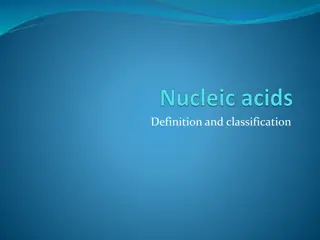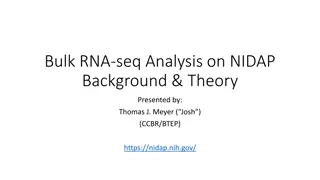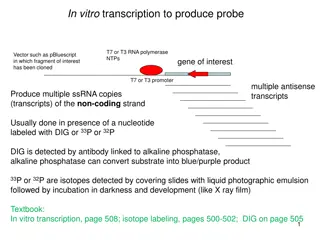Overview of RNA Transcription Process
The process of RNA transcription involves three main stages: initiation, elongation, and termination. Initiation starts with RNA polymerase binding to a promoter, followed by the formation of a transcription initiation complex. Elongation involves RNA polymerase untwisting the DNA helix and adding nucleotides to the growing RNA molecule. Termination mechanisms differ between bacteria and eukaryotes. In bacteria, transcription stops at the terminator, while in eukaryotes, RNA polymerase II transcribes the polyadenylation signal sequence for RNA transcript release.
Download Presentation

Please find below an Image/Link to download the presentation.
The content on the website is provided AS IS for your information and personal use only. It may not be sold, licensed, or shared on other websites without obtaining consent from the author.If you encounter any issues during the download, it is possible that the publisher has removed the file from their server.
You are allowed to download the files provided on this website for personal or commercial use, subject to the condition that they are used lawfully. All files are the property of their respective owners.
The content on the website is provided AS IS for your information and personal use only. It may not be sold, licensed, or shared on other websites without obtaining consent from the author.
E N D
Presentation Transcript
Synthesis of an RNA Transcript The three stages of transcription Initiation Elongation Termination
RNA Polymerase Binding and Initiation of Transcription Promoters signal the transcriptional start point and usually extend several dozen nucleotide pairs upstream of the start point Transcription factors mediate the binding of RNA polymerase and the initiation of transcription The completed assembly of transcription factors and RNA polymerase II bound to a promoter is called a transcription initiation complex A promoter called a TATA box is crucial in forming the initiation complex in eukaryotes
Figure 17.8 1 A eukaryotic promoter Promoter Nontemplate strand DNA 5 3 3 T A A A A A T 5 A T A T T T T TATA box Template strand Start point 2 Several transcription factors bind to DNA Transcription factors 5 3 3 5 3 Transcription initiation complex forms RNA polymerase II Transcription factors 5 3 3 3 5 5 RNA transcript Transcription initiation complex
Elongation of the RNA Strand As RNA polymerase moves along the DNA, it untwists the double helix, 10 to 20 bases at a time Transcription progresses at a rate of 40 nucleotides per second in eukaryotes A gene can be transcribed simultaneously by several RNA polymerases Nucleotides are added to the 3 end of the growing RNA molecule
Figure 17.9 Nontemplate strand of DNA RNA nucleotides RNA polymerase C C A A T A 5 3 C 3 end C U C A A C 5 3 T A G G T T 5 Direction of transcription Template strand of DNA Newly made RNA
Termination of Transcription The mechanisms of termination are different in bacteria and eukaryotes In bacteria, the polymerase stops transcription at the end of the terminator and the mRNA can be translated without further modification In eukaryotes, RNA polymerase II transcribes the polyadenylation signal sequence; the RNA transcript is released 10 35 nucleotides past this polyadenylation sequence
Eukaryotic cells modify RNA after transcription Enzymes in the eukaryotic nucleus modify pre- mRNA (RNA processing) before the genetic messages are dispatched to the cytoplasm During RNA processing, both ends of the primary transcript are usually altered Also, usually some interior parts of the molecule are cut out, and the other parts spliced together
Alteration of mRNA Ends Each end of a pre-mRNA molecule is modified in a particular way The 5 end receives a modified nucleotide 5 cap The 3 end gets a poly-A tail These modifications share several functions They seem to facilitate the export of mRNA to the cytoplasm They protect mRNA from hydrolytic enzymes They help ribosomes attach to the 5 end
Figure 17.10 Protein-coding segment Polyadenylation signal 5 3 G P P P AAA AAUAAA AAA Start codon Stop codon 5 5 3 Cap UTR Poly-A tail UTR
Split Genes and RNA Splicing Most eukaryotic genes and their RNA transcripts have long noncoding stretches of nucleotides that lie between coding regions These noncoding regions are called intervening sequences, or introns The other regions are called exons because they are eventually expressed, usually translated into amino acid sequences RNA splicing removes introns and joins exons, creating an mRNA molecule with a continuous coding sequence
Figure 17.11 5 Exon Intron 5 Cap 1 30 3 Poly-A tail Exon Intron Exon Pre-mRNA Codon numbers 31 104 105 146 Introns cut out and exons spliced together 5 Cap mRNA Poly-A tail 1 146 3 UTR 5 UTR Coding segment
In some cases, RNA splicing is carried out by spliceosomes Spliceosomes consist of a variety of proteins and several small nuclear ribonucleoproteins (snRNPs) that recognize the splice sites
Figure 17.12-3 RNA transcript (pre-mRNA) 5 Exon 1 Intron Exon 2 Protein snRNA Other proteins snRNPs Spliceosome 5 Spliceosome components Cut-out intron mRNA 5 Exon 1 Exon 2
Figure 17.13 Gene DNA Intron Exon 2 Intron Exon 3 Exon 1 Transcription RNA processing Translation Domain 3 Domain 2 Domain 1 Polypeptide
Molecular Components of Translation A cell translates an mRNA message into protein with the help of transfer RNA (tRNA) tRNAs transfer amino acids to the growing polypeptide in a ribosome Translation is a complex process in terms of its biochemistry and mechanics
Figure 17.14 Amino acids Polypeptide tRNA with amino acid attached Ribosome tRNA Anticodon C C G G U G G U U U G G C 5 Codons 3 mRNA
The Structure and Function of Transfer RNA Molecules of tRNA are not identical Each carries a specific amino acid on one end Each has an anticodon on the other end; the anticodon base-pairs with a complementary codon on mRNA
